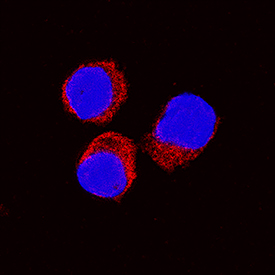Equine IL-10 Antibody Summary
Ser19-Asn178
Accession # Q28374
Applications
Equine IL-10 Sandwich Immunoassay
Please Note: Optimal dilutions should be determined by each laboratory for each application. General Protocols are available in the Technical Information section on our website.
Scientific Data
 View Larger
View Larger
Cell Proliferation Induced by IL‑10 and Neutralization by Equine IL‑10 Antibody. Recombinant Equine IL-10 (Catalog # 1605-IL) stimulates proliferation in the MC/9-2 mouse mast cell line in a dose-dependent manner (orange line). Proliferation elicited by Recombinant Equine IL-10 (20 ng/mL) is neutralized (green line) by increasing concentrations of Goat Anti-Equine IL-10 Antigen Affinity-purified Polyclonal Antibody (Catalog # AF1605). The ND50 is typically 0.2-0.6 µg/mL.
 View Larger
View Larger
IL‑10 in Equine PBMCs. IL-10 was detected in immersion fixed equine peripheral blood mononuclear cells (PBMCs) treated with calcium ionomycin and PMA using Goat Anti-Equine IL-10 Antigen Affinity-purified Polyclonal Antibody (Catalog # AF1605) at 15 µg/mL for 3 hours at room temperature. Cells were stained using the NorthernLights™ 557-conjugated Anti-Goat IgG Secondary Antibody (red; Catalog # NL001) and counterstained with DAPI (blue). Specific staining was localized to cytoplasm. View our protocol for Fluorescent ICC Staining of Non-adherent Cells.
Reconstitution Calculator
Preparation and Storage
- 12 months from date of receipt, -20 to -70 °C as supplied.
- 1 month, 2 to 8 °C under sterile conditions after reconstitution.
- 6 months, -20 to -70 °C under sterile conditions after reconstitution.
Background: IL-10
Interleukin 10 (IL-10), initially designated cytokine synthesis inhibitory factor (CSIF), was originally identified as a product of mouse T helper 2 (Th2) cells that inhibited the cytokine production by Th1 cells. It is a pleiotropic cytokine that regulates the immune and inflammatory responses of hematopoietic cells (1, 2). IL-10 has immunosuppressive activities and has been shown to inhibit the effector functions of monocyte/macrophage and CD4+ T cells. Conversely, IL-10 has immunostimulatory activities and can induce the proliferation and cytotoxic activity of CD8+ T cells and NK cells. IL-10 also regulates the growth and differentiation of B cells, mast cells, dendritic cells and neutrophils (1). The biological activities of IL-10 is mediated by the heteromeric IL-10 receptor complex, which is composed of the ligand-binding IL-10R alpha and the accessory IL-10R beta subunits. Both subunits belong to the class II cytokine receptor family. IL-10R beta is also utilized as a subunit in the heterodimer receptor complex for IL-22, IL-28 and IL-29. Besides IL-10, five novel cytokines (IL-19, -20, -22, -24, and -26) that share structural and limited sequence homology with IL-10 have been identified. These proteins constitute the IL-10 cytokine family (3).
Equine IL-10 cDNA encodes a 178 amino acid residue (aa) precursor protein with an 18 aa signal peptide and 160 aa mature protein that contains two potential N-linked glycosylation sites. Analogous to human IL-10, equine IL-10 likely exists as nondisulfide-linked homodimers. Equine IL-10 shares 71% and 78% aa sequence homology with mouse and human IL-10, respectively.
- Moore, K. et al. (2001) Annu. Rev. Immunol. 19:683.
- Mocellin, S. et al. (2003) Trends in Immunol. 23:36.
- Conti, P. et al. (2003) Immunol. Letters 88:171.
Product Datasheets
Citation for Equine IL-10 Antibody
R&D Systems personnel manually curate a database that contains references using R&D Systems products. The data collected includes not only links to publications in PubMed, but also provides information about sample types, species, and experimental conditions.
1 Citation: Showing 1 - 1
-
Attenuation of AD-like neuropathology by harnessing peripheral immune cells: local elevation of IL-10 and MMP-9.
Authors: Koronyo-Hamaoui M, Ko MK, Koronyo Y, Azoulay D, Seksenyan A, Kunis G, Pham M, Bakhsheshian J, Rogeri P, Black KL, Farkas DL, Schwartz M
J. Neurochem., 2009-09-24;111(6):1409-24.
Species: Mouse
Sample Types: Whole Tissue
Applications: IHC-Fr
FAQs
No product specific FAQs exist for this product, however you may
View all Antibody FAQsReviews for Equine IL-10 Antibody
There are currently no reviews for this product. Be the first to review Equine IL-10 Antibody and earn rewards!
Have you used Equine IL-10 Antibody?
Submit a review and receive an Amazon gift card.
$25/€18/£15/$25CAN/¥75 Yuan/¥2500 Yen for a review with an image
$10/€7/£6/$10 CAD/¥70 Yuan/¥1110 Yen for a review without an image








